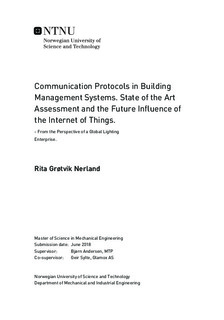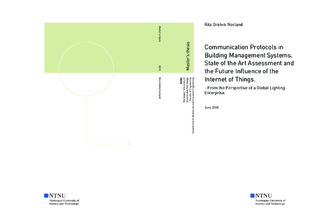| dc.description.abstract | The Internet of Things (IoT), which is about connecting things to the Internet so that the things can be a part of a bigger universe, learning from and to each other, is finding its way to the professional building segment imposing potentially endless new functionalities. But there is one significant obstacle that is limiting the true potential induced by the IoT - namely varying standards which prevent the devices and systems from communicating to each other. A communication protocol is a set of rules and formats that regulates the information exchange between the elements of a system and is the main actor in the standards war. The diverse and contradicting use of different protocols among industry actors and among different building projects is truly slowing down innovation and the transition towards the so-called "thinking buildings". This master's thesis aims to be a part of finding a solution to this problem by answering the research question: "Which communication protocol is most likely to become leading in the light management systems in the professional building market in Europe during the next two till five years and which other communication protocols should the light management protocol be able to interoperate with?"
The thesis uses the global lighting solution enterprise Glamox AS as case enterprise and complements this with a general literature review and a questionnaire study for finding data evidence. The methodology was both qualitative and quantitative and the data was analyzed through Porter's five forces, a simplified Cost-Benefit Analysis (CBA) and a Multi-Criteria Analysis (MCA). Seven sub-questions were constructed to make a more structured approach to answering the research question. The main findings of this thesis were found to be as follows:
The professional buildings are constantly changing and this thesis found that we have a transfer from intelligent to smart to thinking buildings which again can be characterized as a transfer from reactive to adaptive to predictive buildings. Building Management Systems (BMSs) were found to be an essential part of the transfer towards smart and thinking buildings and there were found to be a transition from the traditional way of operation where each technical system have their own IT structure to integrated solutions where the BMS, consisting of both software and hardware, is configured in a hierarchical manner. The transition was however found to be slow and often to originate from the lack of interoperability (the capability of different protocols to understand each other) between the different communication protocols. There was also found that BMSs are frequently divided into the field, automation and management level and that the Open Systems Interconnection (OSI) model is often used as a reference model when comparing and discussing different communication protocols.
There was performed a brief stakeholder analysis and a strategic analysis using the five force model of Porter to analyze the competitive situation for the Light Management System (LMS) segment of Glamox AS. The stakeholder analysis classified the identified stakeholders according to the Savage model and the most dangerous stakeholders were found to be the suppliers, the standardization organizations, the contractors and the shareholders. This is because these are the most likely stakeholders to change the potential for cooperation with Glamox - and turn to the "non-supportive" stakeholder category. The five force analysis found that the total competitive situation for Glamox was moderately in Glamox's disfavour. The main reason for this was found to be the bargaining power of suppliers, the threat of new entrants and the rivalry among the existing competitors. The most important factors in these negative forces were high bargaining power of suppliers of electrical (IoT) components and software, broadened product definition and the pressure from the new IoT products of the existing competitors. Two of the forces were found to be moderately in Glamox's favour. These forces were the "Bargaining Power of Buyers"-force and the "Threat of Substitute Products or Services"-force. The main positive factors in these forces were that increased product differentiation and closer customer relationship can reduce the bargaining power of the buyers and that the threat of substitute products or services might be reduced if continuing success of their LMS.
The literature review found that the communication protocols in a professional building should (1) be suitable for the size of the installation, (2) provide scalability of the network, (3) have the capability to interoperate with other devices and systems, (4) have sufficient range of communication, (5) have sufficient reliability and speed and minimal latency, (6) be secure, (7) have a competitive cost of installation and maintenance, (8) fit device management requirements and (9) be aligned with the industry trends. These nine characteristics were called success factors and were used in the MCAs which compared the three most probable scenarios constructed from the results of the questionnaire. The MCA had a strong conclusion, that Scenario 3, which uses Bluetooth Mesh at the field level and the TCP/IP suite with Wi-Fi at the physical layer at the automation and management level, was the best protocol stack for the office building used as reference. The non-monetary CBA compared the DALI and the Bluetooth Mesh protocol at the lighting field level for four different stakeholders and concluded that the Bluetooth Mesh protocol was most beneficial for Glamox, the building responsible and for the society and that the DALI protocol would be most beneficial for the users of the building. Since the Bluetooth Mesh protocol was found to be the best choice in the questionnaire, the CBA and the MCA, this thesis concluded that Bluetooth Mesh is the most likely communication protocol in LMSs in Europe during the next two till five years. The second part of the research question asks about which protocols the light management protocol should be able to interoperate with and the thesis concluded that the building specific protocols like KNX and BACnet and the current Internet protocol suite, based on the TCP/IP suite, is a poor fit with IoT applications and the future demands of BMSs and that it looks like we are moving towards a more IoT-suited protocol stack using protocols such as IEEE 802.15.4, 6LoWPAN, MQTT and UDP. Therefore, this thesis concluded that the light management protocol should be able to communicate with the future Internet protocol suite based on the transfer to IPv6.
Key Words: Smart Building, Thinking Building, Building Management Systems, Building Automation Systems, Light Management Systems, Communication Protocols, Standardization, Interoperability, Field Level, Automation Level, Management Level, OSI Model, BACnet, KNX, Radio Frequency, Bluetooth, Mesh, TCP/IP, Wi-Fi, Ethernet, DALI, IEEE 802.15.4, MQTT, UDP, IPv6, 6LoWPAN, Glamox AS | en |

